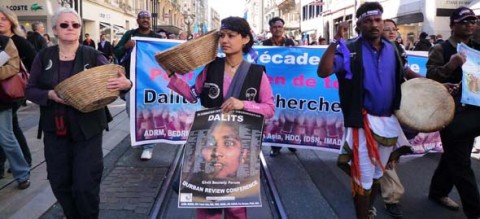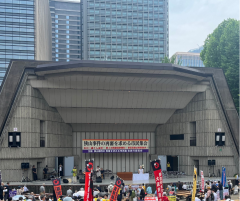 Dalit / Buraku
Dalit / Buraku

IMADR works with Dalit and Buraku communities to address discrimination based on work and descent, leveraging UN human rights mechanisms in collaboration with IDSN and ADRF.
During the 2001 World Conference Against Racism in Durban, Dalit and Buraku communities advocated the inclusion of the term “descent” in the Durban Declaration. Whilst the term “descent” was not included in the declaration, the Committee on the Elimination of Racial Discrimination (CERD) adopted its General Recommendation No. 29 to interpret the term “descent” in Article 1 of the Convention, giving special attention to discrimination against Dalit and Buraku. Joint efforts between the two have brought about good results.
The former UN Sub-Commission on the Promotion and Protection of Human Rights (belonging to the Commission on Human Rights, the predecessor of current Human Rights Council) conducted the study into caste-based discrimination defining it as “discrimination based on work and descent,” and came out with the report entitled the “UN Draft Principles and Guidelines for the Effective Elimination of Discrimination Based on Work and Descent” in 2007 after six years of the study.
Caste-based Discrimination
“Untouchability” has been practiced against Dalit communities in South Asia and other communities which have been suffering from analogue types of discrimination commonly known as caste-based discrimination. The practice of “untouchability” has facilitated segregation, exclusion and unjust and unequal treatment of the affected communities.
▶︎ Physical segregation in: habitation, religious service, school, workplace, public services, etc.
▶︎ Denial of equal opportunities in: education, occupational choice, employment, decision-making, etc.
▶︎ Exclusion from activities in society including: economic, social, cultural, etc.
This has marginalized the affected communities from the mainstream society, and put them in the negative cycle of poverty. They have suffered hereditary discrimination.
What is Buraku Discrimination?
The Tokugawa feudal system set the grounds for how Buraku discrimination functions in modern-day Japan, but it does not fully explain the current manifestations of discrimination. Those facing discrimination are not limited to descendants of Tokugawa outcastes. The original meaning of the word Buraku is ‘neighborhood’ or ‘community’, but it has become shorthand for tokushu buraku, or ‘special communities,’ a euphemistic designation for the neighborhoods in which descendants of outcasts have historically lived. While these neighborhoods were relatively stable during the Tokugawa period, after the Meiji Restoration (1868), populations became more mobile, with events such as earthquakes, wars, and economic growth leading, over the next century, to the massive relocation of people throughout Japan. As a result, people who were not descendants of outcasts moved into neighborhoods formerly designated as outcast, and boundaries of these neighborhoods shifted. Despite these changes, these Buraku neighborhoods are still known, tracked formally in governmental registers and informally in daily conversations that people have about their own neighborhoods and hometowns.
Present-day Buraku discrimination is primarily based on whether a person lives in a Buraku neighborhood, or whether their parents are from such a neighborhood. This means that it is possible for people with no connection to the Tokugawa outcaste status to be labeled as Buraku and face anti-Buraku discrimination. It is even possible for a family to unknowingly move into a historically Buraku neighborhood and, unbeknownst to them, become Buraku. The stigmatized category of Buraku, which is based first and foremost on an individual’s family lineage and occupation, has come also to depend on one’s family address.
The Buraku Liberation League (BLL), as the largest Burakumin’s rights group, estimates that there are over 6 million Buraku people nation-wide. The BLL produces annual reports that track the hundreds of cases of discrimination that happen throughout Japan every year, cases which include harassment and refusal of marriage or employment. The political movement’s efforts have resulted in great improvements in the quality of life in Buraku neighborhoods, the elimination of physical violence against Buraku people, and a continuing reduction in other forms of discrimination as well. However, anti-Buraku prejudice is still prevalent throughout the country, and discrimination remains a key issue.
The Sayama Case
On May 23, 1963, Kazuo Ishikawa, a man of Buraku origin from the town of Sayama, north of Tokyo, was convicted and sentenced to death for a crime he did not commit. Though Mr. Ishikawa is now released on parole, his sentence has not been cleared yet. For more information, please visit the page of the Sayama Case.
Suiheisha Declaration
On March 3, 1922, Burakumin gathered in the city of Kyoto to hold the founding convention of the National Levelers Association. “Suiheisha Declaration”, which was proclaimed at the convention, still lids light on people today, encouraging not only Burakumin but also those who have suffered from various forms of discrimination. It is said to be the first human rights declaration in Japan and shows us the pride and dignity of human beings in the modern world.




